Abstract
The present work aims to analyze the implications of the educational environment of school on learning with higher secondary school students. The theoretical framework this research relied on considers the functionalist-systemic paradigm of Talcott Parsons (1902-1979). According to Parsons, school, regarded as a social system, needs to answer the following functional imperatives: adapting the students to the institutional environment, reaching the educational goals, socio-educational integration, accepting and supporting cultural values, stimulating motivation for learning. The specific objectives of the research were: identifying the level of importance perceived by the students regarding the actions undertaken by the school on the individual level in order to support school success (SO1); identifying the level of importance perceived by the teachers regarding the collective educational actions undertaken in order to obtain school success (SO2). The research is of a standard type: qualitative and quantitative. The measurement of the result was realized using a Likert scale and the data interpretation was realized based on the interpretations obtained through the use of the bidimensional matrix of Nice &Gaps type. The results of the research have led to the following conclusion: the quality of the institutional and familial educational environment is a major condition for individual school success. This aspect is justified in the context of a direct correlation between the individual factors and the functional and structural capacity of the school and of the family.
Keywords: EducationParsonseducational environmentschool successsystemic functionalism
Introduction
We often ask questions and try to find explanations for the actions we undertake, we or those around us. Why do we realize what we realize? Why is one student more diligent, and another one is not? Why does a student persevere when we discuss about reaching goals, while another one is discouraged and refuses to approach the problem, abandoning at the first obstacle he meets? The answer to these questions derives from the analysis on motivation and the motivational factors. Motivation is “the set of dynamic factors determining an individual’s conduct” (Sikkamy, 1996. 202 apud Sălăvăstru, 2004, 69). It is appreciated that education takes place under the influence of ample sets of reasons that support, kindle and intensify, or diminish, block or interrupt learning. The pertinent analyses realized on the factors involved in the structure of motivation delimit various groups of reasons. One of the frequently accepted classifications is the one dividing the reasons of learning into two categories of motivation: intrinsic and extrinsic. (Neacșu, 2015, 74). There are situations when an extrinsic motivation can lead to an intrinsic motivation; such is the case of a child who initially learns to get good marks and finally, as he assimilates knowledge, gets to learn out of passion and interest. Ausubel and Robinson (1981, 417-418) consider that the motivation lying at the basis of the realizations in the school environment has three components: cognitive impulse, need for affiliation and strong need for self-affirmation. The cognitive impulse relies on the need to know and to understand, to master knowledge and to solve and formulate problems. This impulse is totally turned to the didactic task and is satisfied by accomplishing it. The need for self-affirmation is oriented towards reaching a significant school output because it can assure a certain prestige. The encouragement by the teacher meets the need for affirmation of the self in its quality of component of the motivation of the learning activity. The guidance of the motivational system and the control of the instructive-educative activities represent two of the difficult problems the educator is faced with. They can be solved easier if the student’s personality and his evolution are known. The students’ motivational dynamics is a complex phenomenon, which can be influenced by a multitude of external factors. Among them, the most important are the factors having to do with the student’s personal life, the social factors, factors having to do with the features of the class and factors having to do with the school. The teacher can control neither the social factors, nor those having to do with the student’s personal life. However, he can have an important role by monitoring and controlling the factors having to do with the school (Neacșu, 2015, 74).
School practice outlines a series of motives, such as: cognitive motives, professional motives, individual motives, social-moral motives and relational motives. Professional motives refer to centering the act of learning on the future profession. This type of motive is met especially among high school students who are about to make a decision regarding their future profession. The cognitive motives focus on
School success supposes an actual success, a correspondence between achievements and potential, a correspondence accompanied by a positive evaluation by the teacher. The reasons of school success consist in the high level of training, the high level of development of the intellectual processes, in a state of good rest and good health, in the positive pedagogical influences of the teacher, of the peer group, of the school schedule and of the school endowments, in the beneficial influences of the family environment, in the positive influence of the general cultural environment of living and in the need for culture (Turcu, 1999, 58). The lack of harmony between school demands, performances and learning efficiency, evaluated per se by the teacher, is expressed in school failure or lack of success. In relation to the individual, the factors influencing school success are structured in: external factors (social factors: structure of the family and family climate, living conditions, economic level, environment of origin, access to high-quality educational services) and internal factors (individual intellectual potential – intellectual level, mental health, biological health).
It has been noticed that school success is met especially among children coming from families that admit the importance of education in social development and integration. Among the biological factors we shall remind of: genetic potential, particularities of the sensory organs, physiological balance, good functioning of the central nervous system and general health state. The pedagogical factors refer to the good organization of the instructive-educative process, with the use of optimizing teaching strategies, with democratic relational styles between teacher and students and with the good functioning of the students’ class as a social group.
The psychological factors represent internal factors having to do with the student’s personality. A special place among them goes to intelligence. Intelligence is considered to be a knowledge tool independent from affectivity or will. It includes all the psychic functions or processes whose object is knowledge. School results, the status of a student as “good” or “weak”, the failure or success at the exams certainly influence the student’s status in his peer group and in his family. School itself is evaluated in the society according to the results obtained by its students.
Thus, school success represents a standard for the quality of all those involved in the instructive-educative process, whereas school failure contributes to the depreciation of the individual, of the school and of the family, and often becomes synonymous with failure in life. School failure no longer represents just a pedagogical problem, but also a social problem (Sălăvăstru, 2004, 229).
Out of the indicators used to appreciate the existence of a situation of school failure, one can mention: early school leaving, leaving school without a professional qualification, gaps between personal potential and results, incapacity to attain the pedagogical objectives, failure at final exams and school inadaptation.
Problem Statement
The following explanation is considered: the educational environment is defined in the context of the consideration of the learning environments operationalized by reference to the environment of the school organization and the environment of the family, which influence the students’ motivation in relation to learning and stimulate school success. It is considered that there is a direct correlation between the external factors (having to do with the environment where the student lives and functions) and the internal environment specific for each individual in assuring school success and increasing the motivation for learning.
Research Questions
What are the factors directly influencing the motivation for learning among students? To what extent does the environment in the family influence school success? What are the factors specific for the social environment of school that can influence the school trajectory?
Purpose of the Study
This research aims to analyze the implications of the educational environment of school on learning with higher secondary school students.
Research Methods
In harmony with the research goal, we have considered the following specific objectives: identifying the level of importance perceived by the students regarding the actions undertaken by the school on the individual level in order to support school success (SO1); identifying the level of importance perceived by the teachers concerning the collective educational actions undertaken to obtain school success (SO2). In this sense, the following working hypotheses have been formulated: the higher the importance given by the teacher to the individualization and differentiation of the training, the higher the school success rate and the motivation for learning are (H1); if the family actively participates in monitoring the school evolution of the children, then the school failure rate is lower (H2). The research is of a standard type: qualitative and quantitative. The analysis unit was represented by a heterogeneous group of 100 secondary school students coming from the urban and rural environment, homogeneously distributed and the group of teachers (25 teachers). The research tools used were: structured questionnaire (quantitative research) and structured interview (for the qualitative research). In the case of the quantitative research, the results were measured using a Likert scale. On the level of the educational environment of school, the following dimensions have been considered: the socio-cultural environment of the school, the quality of the educational act (teaching style, quality of the didactic evaluation, class infrastructure (class population, ethnic structure, students’ level of residence, economic level of the family), school laboratories (logistics/ learning toolkit), the relation teacher-student (attitude and behavior of the teachers in class). The following factors influencing school success have been considered: individualization of the training, differentiation of the training, qualitative evaluation, implementation of the individualized educational plan, school counseling, valorification of the aptitudes of each student. Regarding the actions realized by the teachers, undertaken in order to obtain school success, the following dimensions have been analyzed: communication with parents, identification of the needs of each student in order to assure school success, adaptation of the instructive educative process. The measurement of the results was realized using a Likert scale and the data interpretation was realized based on the interpretations obtained by the use of a bidimensional matrix of the Nice &Gaps type.
Findings
In harmony with the first specific objective of our research, the identification of the level of importance perceived by the students concerning the actions undertaken by the school in order to support school success (Fig.
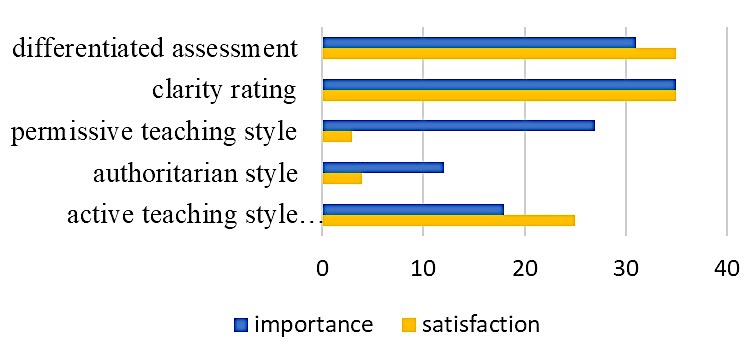
One can notice that the students consider very important the perspective of the evaluation for learning, responsible for school success. In this framework, the active participative methods used by the teachers in the training process are an active part that can influence the quality of the evaluation. Dissatisfaction towards the authoritarian style has a negative influence on the students’ involvement and responsibility in learning.
Regarding the teachers, the distribution of their answers appears as follows (Fig.
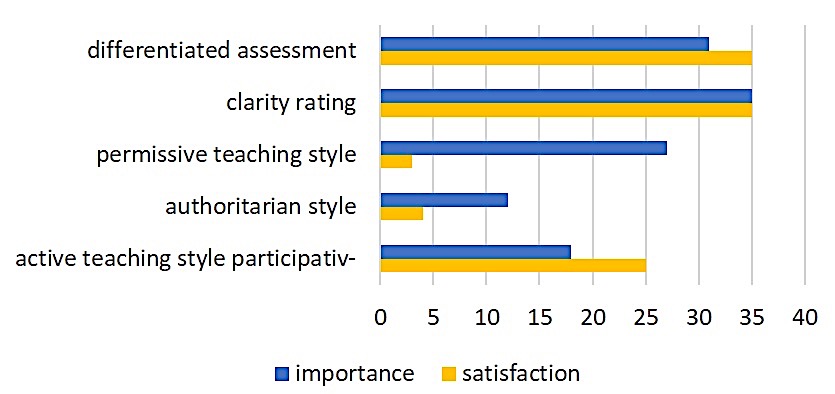
One can notice that, unlike for the students, the evaluation in the instructive-educative process is considered an important dimension in stimulating the motivation for learning, for which the teachers have a high level of satisfaction. This demonstrates that the measurement of the results of learning unfolds according to a model imposed in an authoritarian manner, which triggers the students’ dissatisfactions in relation to school motivation and school success. Regarding the influence of the social environments on the students’ motivation for learning, the following dimensions have been considered: the structure of the students’ classes (class with students with special educational needs, class with students of other ethnic groups, mixed class (urban, rural), class with children from poor families). The distribution of the answers appears as follows (Fig.
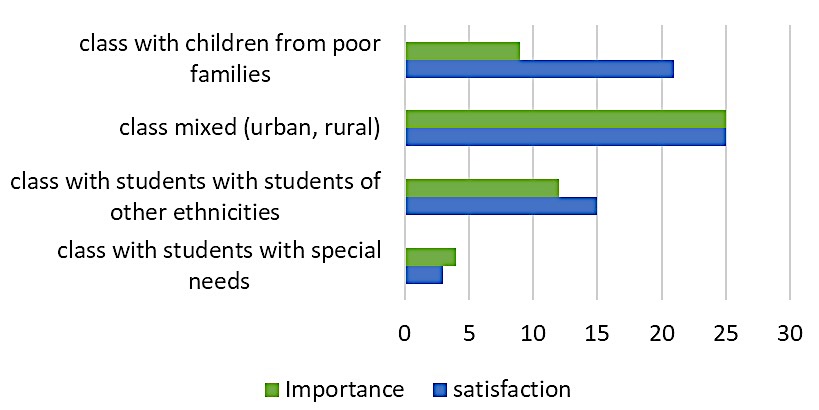
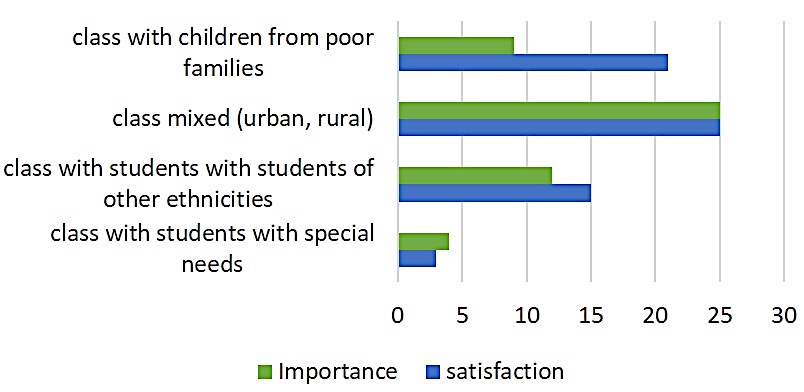
One can notice that both the students and the teachers give importance to the role of competition in the motivation for learning, mixed heterogeneous classes being a model in this sense. This aspect is demonstrated as well by their perception about the importance of the heterogeneous ethnic classes, the education in an intercultural context being liked and considered a stimulating learning environment. The results confirm the hypothesis according to which a differentiated and individualized training influences the motivation for learning (H1). Regarding the implications of the family on the school level, from the qualitative research – the structured interview with the parents – the hypothesis according to which the active involvement of the family in the monitoring of the school evolution of the children assures school success. In this case, we appreciate that it is necessary to implement active measures on the level of each school, meant to stimulate the active participation of the postmodern family in the educational development of the child (Fig.
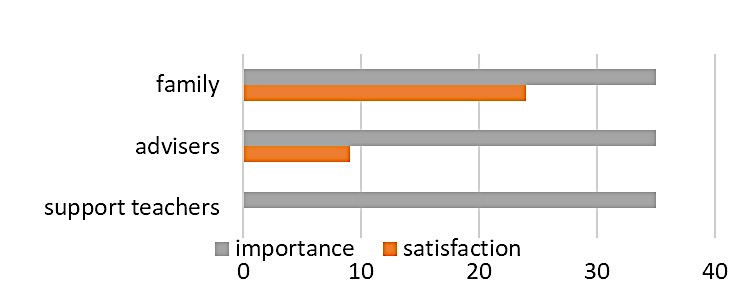
Conclusion
The quality of the institutional educational environment is a major condition for individual school success. It has been noticed that there is a direct correlation between the individual factor and the school’s functional and structural capacity. A clear evaluation and an active participative teaching style are key elements stimulating learning (similar opinions for students and teachers). The differentiated instructive educative process, although acknowledged by the teachers as being important and generating the greatest satisfaction (clarity in evaluation, objective criteria, estimative evaluation), is not sufficiently used. The family has a fundamental role in influencing and maintaining school success beyond the school’s active involvement. So, we plead for the identification of active measures centered on the family on the school level, meant to support each child’s success. The partnership school-family proves to be the central link supporting the quality of each student’s education.
References
- Ausubel, D., Robinson, F. (1981). Învăţarea în şcoală. O introducere în psihologia pedagogică. Bucureşti: Editura Didactică și Pedagogică.
- Neacșu, I. (2015). Metode și tehnici de învățare eficientă-fundamente și practici de succes. Iași: Editura Polirom
- Turcu, F. & Turcu, A. (1999). Fundamente ale psihologiei școlare. București: Editura All.
- Sălăvăstru, D. (2004). Psihologia educației. Iași: Editura Polirom.
Copyright information

This work is licensed under a Creative Commons Attribution-NonCommercial-NoDerivatives 4.0 International License.
About this article
Publication Date
30 July 2017
Article Doi
eBook ISBN
978-1-80296-026-6
Publisher
Future Academy
Volume
27
Print ISBN (optional)
-
Edition Number
1st Edition
Pages
1-893
Subjects
Teacher training, teaching, teaching skills, teaching techniques,moral purpose of education, social purpose of education, counselling psychology
Cite this article as:
Anghel, G. A., & Anghel, G. A. (2017). The Educational Environment Of School And Its Implications On Learning. In A. Sandu, T. Ciulei, & A. Frunza (Eds.), Multidimensional Education and Professional Development: Ethical Values, vol 27. European Proceedings of Social and Behavioural Sciences (pp. 12-18). Future Academy. https://doi.org/10.15405/epsbs.2017.07.03.3

